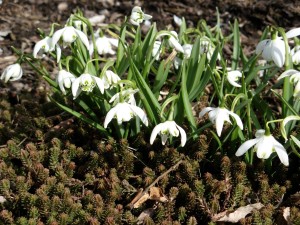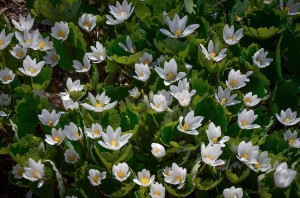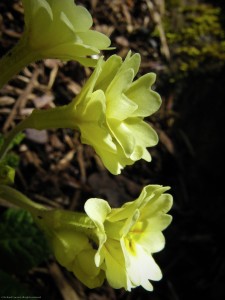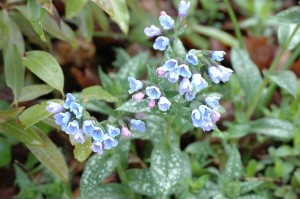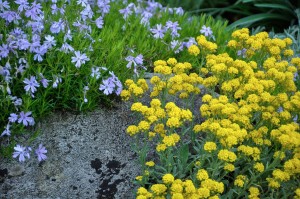No winter lasts forever; no spring skips its turn
After a long erratic winter, every New England gardener I know is impatiently anticipating spring. It is mid-March as I write this, and a deep mantle of snow still blankets my garden.
But in a few short weeks the snow will recede, and I will be anxiously watching for those telltale signs of green that signal the land is starting to awaken from its extended winter sleep.
Yellow and white: the earliest flowers of spring
Along with the little green shoots, I will also be eagerly awaiting the first flowers of spring, both in the hedgerows and in the garden. Of course the daffodils are by far the most exuberant spring flowers, their cheery yellow faces greeting the season with a smile.
They are completely carefree, shunned by deer and multiplying without help from the gardener, as you can see in this picture of an old pasture not so far from where I live.
But there are other harbingers of spring which, while a tad more modest than the daffodils, are no less lovely.
Here are my favorites that over the years have also grown and multiplied in my Goshen garden, returning every April to tell me winter has finally gone.
Snowdrops.
The first to emerge will be the pure white snowdrops that now fill wide swaths of the slope up towards our barn. One autumn about seven years ago I nestled approximately 50 bulbs all across the area. Now each small bulb has become a small colony, and sometimes in early April, as I glance up towards the barn, for a moment I imagine that winter’s snow has returned.
Snowdrops originate in Europe and, while Wikipedia will tell you they typically flower before the Vernal Equinox, here in Vermont they postpone their flowering until the earth is free from snow and has begun to warm in the spring sun. Once flowering is done their green leaves remain for about a month as the plant makes food for the coming year. Then almost overnight the leaves vanish and everything is hidden from view until the following spring.
Find a partial shady spot in your garden where the soil does not readily dry out and plant a few bulbs, either in late spring or next fall and, for years to come, their dainty white flowers will herald the arrival of spring.

For many years this patch of snowdrops growing beside an abandoned farmhouse returned to greet the new season.
Last summer the house was demolished but I’m betting the snowdrops will still reappear a few weeks from now.
About a mile north along our mountain road there was an old farmhouse where, every spring, I would eagerly anticipate the mass of snowdrops that pushed their way up through the leaves and rough grass beneath the lilac bushes on the south-east corner of the house. Over the years, the house gradually fell into disrepair, and last summer it was demolished. Like our house, it was built about 1845, and I was so sad to see it go. But I am betting this April those snowdrops will again return, creating a small remembrance of the many people who enjoyed that house for so long.
Hellebores
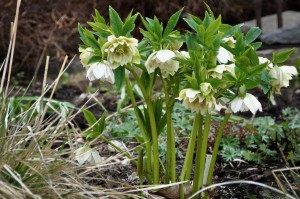
In the north country ‘Lenten Roses’ or Hellebores do not bloom in Lent, but rather they wait until the snow has receded and the soil begun to warm.
Hellebores are another early spring flower from Europe. However, unlike snowdrops, the palmate hellebore leaves remain above ground to gradually form a handsome clump that contributes to the shady garden throughout the summer.
The Hellebore genus consists of over a dozen species, some with English names such as Christmas Rose, Lenten Rose, and even Stinking Hellebore. Many species have also been hybridized to provide a wide range colors from a parchment white all the way to dark red (sometimes described as black).
At first I was dubious about trying a plant with the name of Lenten Rose in my Vermont garden, thinking that most years it is under snow throughout all of Lent.
So for a while I grew a couple of Hellebore plants in my cool greenhouse and enjoyed their flowers in early March. I finally decided to experiment with some outdoors and I am delighted to report that, like snowdrops, they conveniently postpone their flowering until the snow has receded and the soil has warmed a little. Since they also take a late frost in their stride, they have made the perfect addition to my early spring garden.
Bloodroot
About a decade ago I decided to clear our ‘barn slope’ and plant a garden. There was little of interest to save, apart from the tiniest patch of Bloodroot, Sanguinaria canadensis. Every year I had marveled as a few clear white flowers, like miniature anemones, emerged between the thick grasses and ferns that at that time completely dominated the slope, amazed that such a delicate plant could survive under such adverse conditions.
So, in preparation for clearing the space, I carefully dug the single rootstock which easily broke into smaller pieces that indeed exuded a reddish liquid reminiscent of blood. I tucked the pieces into various shady corners around the garden, and now I am rewarded each year with dense patches of delicate white flowers, followed by the scalloped leaves which, like the Hellebores, last all summer long.
Bloodroot, or Sanguinaria canadensis, is native to the eastern half of the United States and Canada, and in my garden it blooms around mid-April unless the snow is very slow to recede.
English primroses
Each time I see yellow English primroses, Primula vulgaris, I am transported back to my childhood in the countryside of Kent (England). Not far from our house there were some ‘primrose woods’ where, each April, yellow primroses stretched as far as the eye could see, truly a sight to behold. Primula vulgaris are native to much of Europe but, sadly, today they are relatively rare in the wild, and in many countries picking or digging them is now illegal.
It was twenty years ago when I saw the small pot of the double ‘Hose-in-Hose’ English primrose for sale at Rocky Dale Nurseries, and I knew I ‘had ‘ to have it. My garden has proven a good match for these sometimes finicky plants. Again, by placing them in shady corners and carefully dividing the clumps every few years, from that one original plant I have created many clusters in spots all over the garden.
The complete Primula clan or genus is quite large and it hails from across the globe. Many gardeners are familiar with the Drumstick Primrose with a spherical whorl of flowers atop an eighteen inch stem, as well as the similar sized Japanese primrose that enjoys a boggy spot.
And, as with the Hellebores, cross breeding of Primula has produced a wealth of cultivated varieties or cultivars for the discriminating gardener. They come in an array of bright colors, including oranges and pinks, as well as deep purple to pale mauve, and specialized nurseries like Rocky Dale Nursery in Bristol and Cady’s Falls Nursery in Morrisville carry many types to please all tastes. Indeed I have quite a number of different ones here in my garden that spread their flowering times out all the way to early June.
But, when all is said and done, my heart belongs to the diminutive Primula vulgaris which, when they flower in late April in my Goshen garden, will transport me back across the years and across the miles.
Beyond yellow
The earliest spring flowers are mostly white or yellow, but it is not long before other colors make nice additions to our floral pictures.
I generally favor plants with longevity that will gradually expand to fill their allotted space without overreaching. So long ago, despite their bright colors and perky shapes, I gave up on tulips and crocuses. It seemed that each new planting would last only a couple of years before becoming an extensive winter larder for the voles.
But here are some lovely plants in colors other than yellow and white, that also return each year to brighten my spring garden:
Virginia Bluebells

Mertensia virginica, or Virginia Bluebells are a beautiful native plant that thrives all the way into Zone 3.
Our native Virginia Bluebells or Mertensia virginica make perfect companions for the yellow English primroses since they thrive in similar conditions and flower at the same time. And besides, the contrast of their true-blue nodding flowers behind a carpet of the yellow is completely captivating.
Since Virginia Bluebells go dormant after flowering (like our spring bulbs), take care to avoid disturbing their small brown roots as you do your summer weeding.
Pulmonaria
The spotted leaves of Pulmonaria reminded people of a diseased lung, hence its common name of Lungwort. But do not let that deter you from using these easily grown plants in the garden. In colors ranging from deep blue to raspberry pink they give a lift to the spring garden.
Cut the leaves back after flowering to stimulate a fresh mound of foliage for the summer. The new spotted leaves will remain throughout the summer and create a nice textural contrast among some small hostas and ferns.
Phlox subulata
Most gardeners are familiar with the easily grown creeping phlox or Phlox subulata. This light mauve one in my garden spills over a large rock alongside some bright yellow ‘Basket of Gold’ Aurinia saxatilis.
And after flowering the dense mat of leaves looks almost like moss.
Primula kisoana
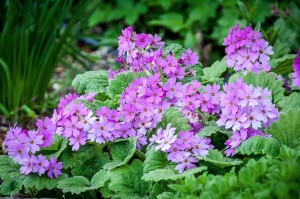
Choose a spot where this lovely Japanese primrose, Primula kisoana, can weave among some other robust groundcover plants
And last, cautiously, I mention is this Japanese primrose, Primula kisoana. Each spring its lovely pink flowers look stunning under my serviceberries.
In the summer the mat of hairy scalloped leaves make an irresistible groundcover that people like to gently caress. And the leaves look lovely as they weave among some Lamium maculatum with its silver and green variegated leaves.
But be warned: over time Primula kisoana will wander through the bed, spreading outwards to cover a wide area. So plant it ONLY where this will not be a problem. Or alternatively, to keep it in its place, use some plastic edging to fashion a simple root barrier.
Spring dreams
So as I wait for this seemingly long winter to run its course, I reflect on these words of wisdom by American writer and journalist, Hal Borland, while I look forward to welcoming all the delicate flowers of spring:
No winter lasts forever; no spring skips its turn!

